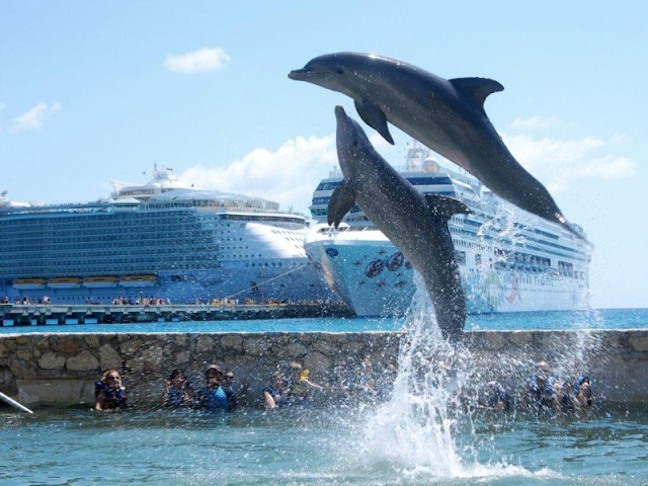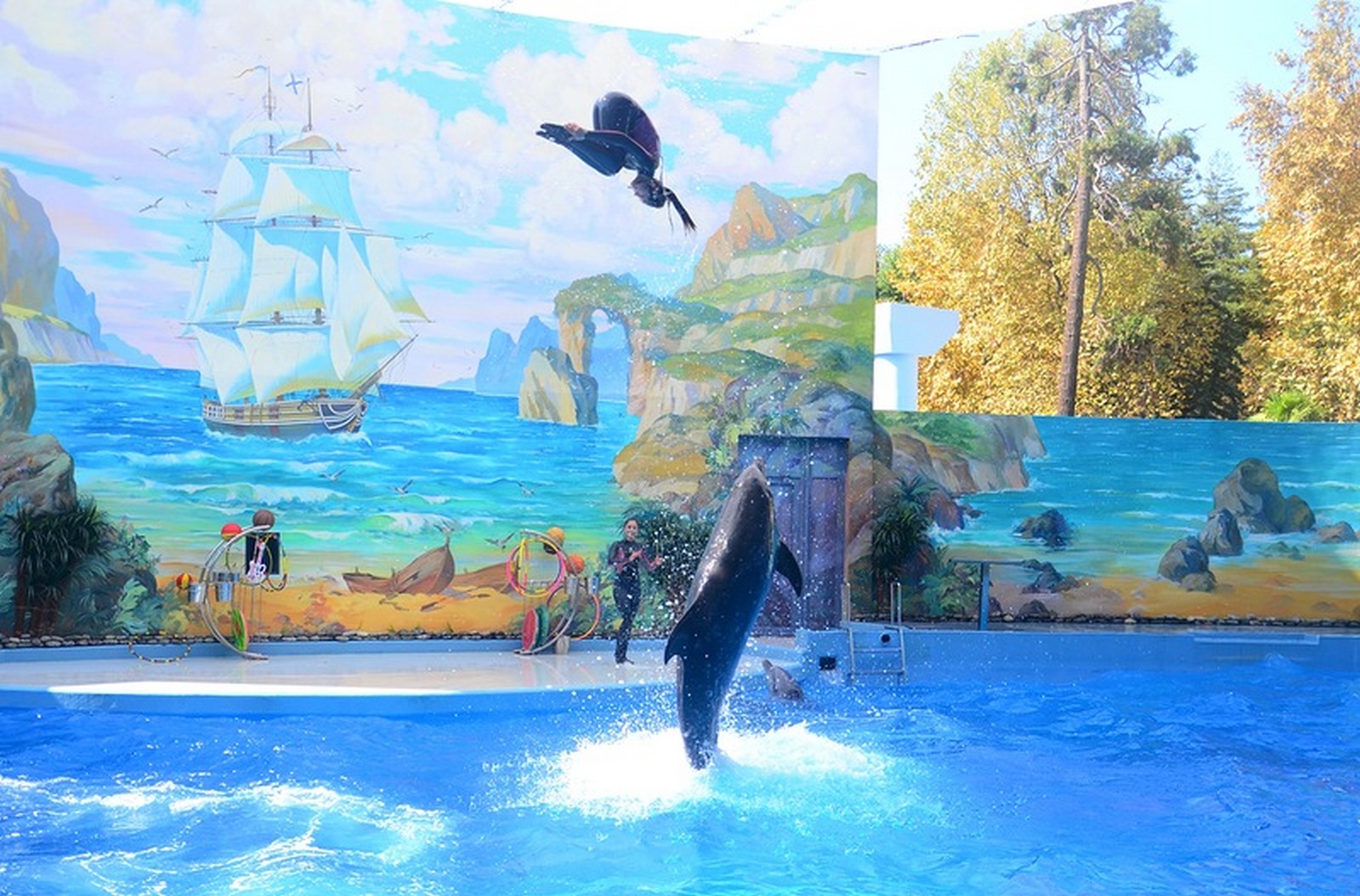CHARLOTTE AMALIE — People here are organizing against a “dolphinarium” proposed for Coral World on St. Thomas — what they call a “dolphin prison” with vast environmental impacts to nearby beaches from the food the mammals leave behind — and the feces they leave behind as well.
Marie Bernard and others on Facebook have asked people who are concerned about the proposal to address their concerns to the U.S. Army Corps of Engineers which must approve the permit for Coral World as well as the Department of Planning and Natural Resources here.
“Are you kidding me?” Bernard asks on Facebook. “Coral World is moving forward and trying to sneak their dolphinarium disaster in through the permitting process during the post-hurricane Irma and Maria chaos! This can’t happen. America has already rejected SeaWorld and so has most of Europe and South America.”
Environmentalists and animal rights experts say that there are many “environmental issues (the scope of this permit does not cover the ethics of keeping dolphins in captivity).”
“Cetaceans produce a significant amount of waste on a daily basis, which in the wild is normally not concentrated in a single location,” animal rights experts said. “If flushing of the proposed dolphin enclosure area through tidal flow and/or current is inadequate, then the waste from several dolphins and decaying fish parts that these dolphins
do not consume during feeding can concentrate in an abnormal manner and accumulate around and through reefs. This material, consisting of organic debris, nutrients, and fecal coliform bacteria, can cause abnormal levels of algal growth, which can smother and kill corals and also sea grass beds. Biodiversity in such affected areas can decrease substantially – a study by Goreau (2003) suggests that this negative impact on reefs near open water dolphin pens has already occurred in Cozumel.”
Bernard said “there is no room for captive sea mammals in this eco-friendly world.”
“The proposed Dolphinarium will be located in Water Bay which is enclosed and collects runoff and from Smith Bay,” she said. “This will create a cesspool with dolphin feces and Sargasso seaweed. We haven’t had swimmers in Water Bay in 10 years. If this disgusting dolphin jail were to slip through permitting it would ruin Water Bay forever.”
The permit application cites only one study in its discussion of mechanisms by which dolphin waste will be eliminated from the enclosure: (Sazima 2006) which reports that dolphin waste is naturally consumed by certain fish species that associate with dolphins.
The permit application implies that this fish consumption will reduce the dolphin waste burden inside and even outside the enclosure substantially. But animal rights experts said that the study cited is an apples and oranges type comparison.
In addition, the study focused on a different species (spinner dolphins) and an entirely different ecosystem (and hemisphere – the study was conducted in Brazil). While it is probable that some dolphin feces in Water Bay will be consumed by some fish, this is unlikely to be a major mechanism of eliminating waste from the enclosure or outside it, as 1) the waste will be concentrated in an artificial manner (see above) and 2) the fish species in Water Bay will not rely on dolphin waste as a food source, given that wild dolphins do not regularly inhabit this area and this type of scavenging relationship will have had no opportunity to evolve as a result.
Coral World plans to relocate a large number of heads of the boulder coral, Montastrea annularis (which will soon be listed under the U.S. Endangered Species Act), as they are found within the footprint of the proposed enclosure. Coral World claims that other corals outside of the footprint will not be affected, due to flushing of the enclosure area. These more distant corals are endangered (Acropora palmata) or about to be listed (Dendrogyra cylindrus), which emphasizes at a minimum the need for references supporting these optimistic claims (no references supporting these predictions of “no impact” are provided in the permit application) and potentially the need for focused studies examining how this concentration of wastes might affect the corals in Water Bay. An ESA Section 7 consultation will also be required.
· Coral World is also claiming that water quality overall in the area will not be affected by the dolphin enclosure, either during construction or operation. These claims again are difficult to evaluate without knowing more about the water movement in Water Bay and the effect on that movement from the fencing and wave barrier to be installed. The permit application acknowledges that the fencing and wave barrier will reduce water movement, but downplays its significance. The claim that other sea pen enclosures have not experienced water quality impacts is both incorrect and irrelevant. There are in fact other facilities (see, for example, Alaniz and Rojas 2007) that have had significant water quality impacts; and while some facilities may have had minimal impacts, the water movement (and thus flushing of effluent) in these other areas may be greater than in Water Bay. Coral World provided water quality information for several other facilities, but no water movement data – both are necessary to support any comparison between two different sites.
· Coral World acknowledges that eutrophication has been an issue in Water Bay in the past but implies that this is a minor and easily addressed concern, when in fact there is insufficient information in the permit application to support this optimism.
· The permit application claims that harmful algal blooms are rare in the Virgin Islands. The lack of harmful algal blooms in the Virgin Islands historically is not a valid predictor of their future occurrence, given that the occurrence of harmful algal blooms is increasing globally.[1]
· At a minimum, adequate references must be provided before a confident conclusion can be drawn regarding the suitability of this site for a dolphinarium in regards to water quality. The permit application mentions “a number of studies…in regard to dolphin enclosures” (p. 92) and water quality that have been conducted, but does not cite them – at a minimum, Coral World must provide these citations.
++++++++++++++++++++++++++++++++++++
If you haven’t already sent a letter requesting a public hearing and an an extension of the 20-day Public Comment period (woefully inadequate for such a major and controversial project) then you can include that in your Comments letter.
Organizers said the deadline for comments is November 27 so please mail your letter right away to:
Mr. Edgar Garcia
District Engineer, Antilles Permit Section
400 Fernandez Juncos Avenue
San Juan, PR 00901
Please reference: Coral World Dolphin Exhibit Enclosure
File: SAJ-1976-89037 (SP-EWG)
Sorry, there is no email address to send Comments, they must be mailed.
POINTED DEBATE: Environmentalists and animal rights experts say a planned “dolphinarium” will add to the pollution problems nearby Coki Point beach already faces in St. Thomas. The beach has failed DPNR water quality testing more than any other beach in the Virgin Islands in 2017.


